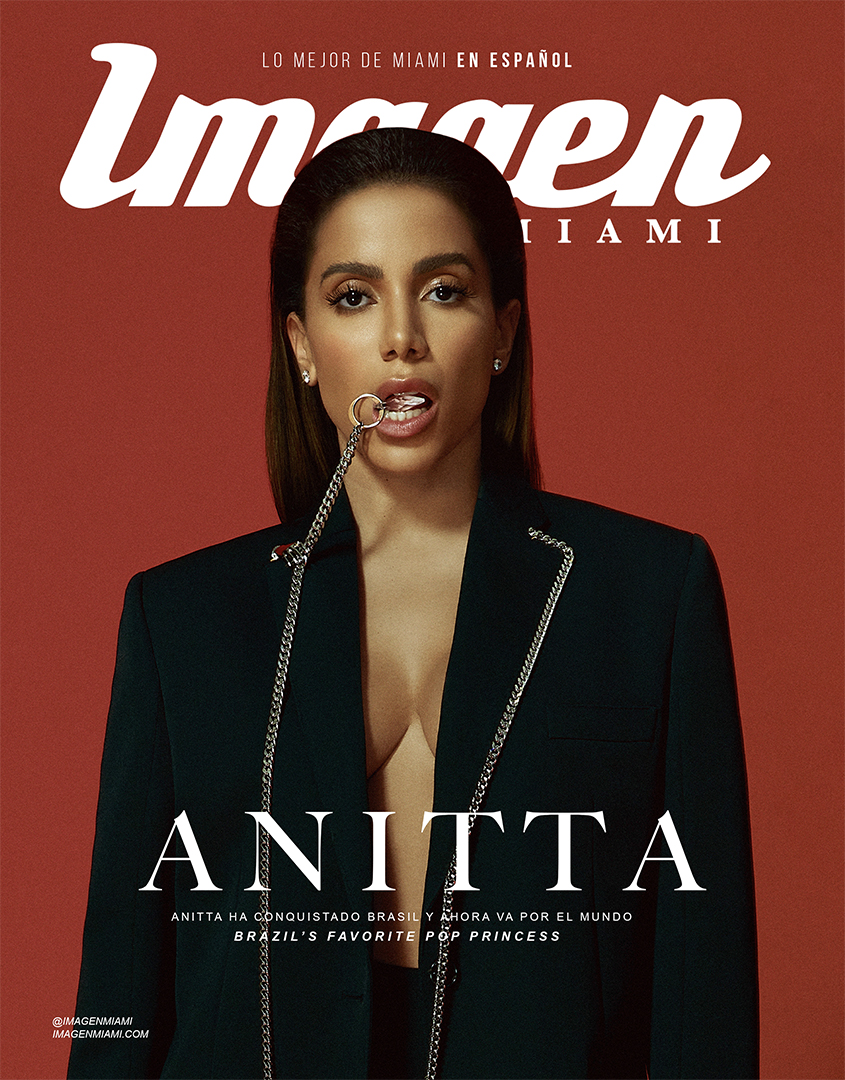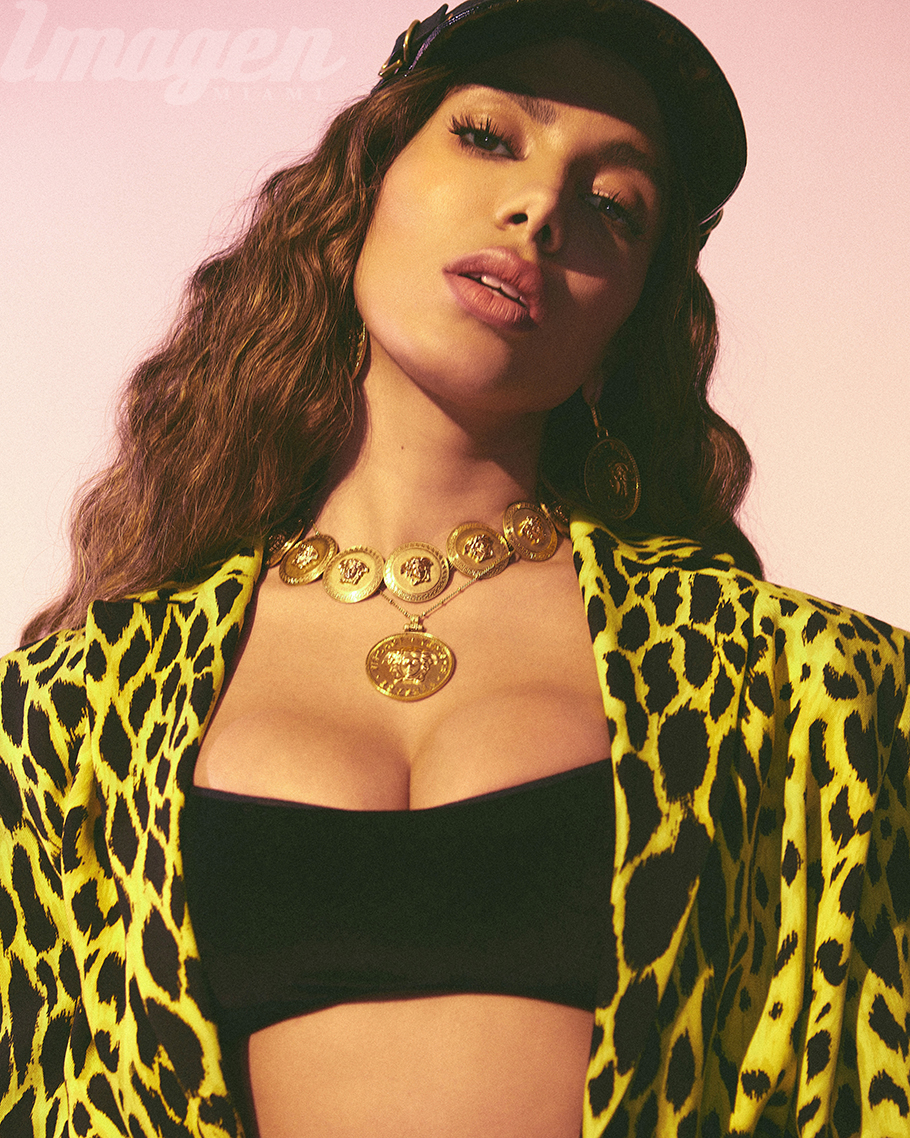Anitta es la portada Número 17 de Imagen Miami

Entrevista por Luisa Rangel, Fotografía Fernando Tomaz Interview by Luisa Rangel, Photography Fernando Tomaz
Cuando hablas con un artista tienes tiempo limitado, son por lo general 20 minutos, parece suficiente pero no lo es, me gusta saber acerca de detalles que no se conozcan y sobre todo que transmitan sentimientos. Pensaba la manera de comenzar mi charla con Anitta, ¿qué podía preguntarle? Siempre he creído que esas primeras palabras son claves para conectar, para que la conversación surja de la mejor manera, no me gusta pensar en entrevistas, si no en mensajes.
When you speak to an artist, you have limited time, usually 20 minutes, and it may seem long enough but it is not; I like to know about details that are not known and, above all, that convey feelings. I was thinking about how to start my conversation with Anitta, what would I ask her? I have always believed that those first words are key to connect with the artist so that the conversation emerges in the best way. I do not like to think of the conversation as an interview but more like in messages.
Esta vez hice un ejercicio diferente, se me ocurrió pedirle que cerrará sus ojos y pensara en su infancia y en esa primera canción que recordaba. Con una gran sonrisa y como si tuviera puestos unos auriculares moviéndose a ritmo de la canción, abre sus ojos y me dice: – Fantasy de Mariah Carey, no estoy segura a que edad exactamente la escuchó, ella tendría dos años cuando esta fue lanzada, pero me cuenta con emoción que es la primera canción y cantante que recuerda haber escuchado en su vida, gracias a que su madre y tías eran grandes fans y no paraban de escuchar y bailar su música.
This time I tried a different exercise, it occurred to me to ask her to close her eyes and think about her childhood and the first song she remembers. With a big smile and as if she was wearing headphones moving to the rhythm of the song, she opens her eyes and tells me: “Fantasy by Mariah Carey.” I’m not sure at what age she heard it exactly, she was two years old when it was released, but she tells me with excitement that it is the first song and singer that she remembers hearing in her life, thanks to the fact that her mother and aunts were big fans and did not stop listening or dancing to her music.

Como si fuera un plan del destino, hoy la gran carrera de Anitta es comparada a la de grandes figuras como Mariah Carey, Beyonce, J Lo. Anitta fue la primera mujer que llevó el Pop al Funk Carioca de su país y ahora al mundo.
As if it were a plan of destiny, today Anitta’s great career can be compared to that of great figures like Mariah Carey, Beyonce, and J.Lo. Anitta was the first woman who brought Pop to Carioca Funk in her country and now to the world.
No muchos estamos familiarizados con el termino funk, por lo menos no como lo conocemos internacionalmente que poco tiene que ver con el sonido de Brasil. Es un sonido musical nacido en Rio de Janeiro muy popular en las favelas, razón por la cual no era considerado para consumir en el resto de Brasil ni mucho menos a nivel internacional. Ese sonido es precisamente lo que ha caracterizado a Anitta y parte de su éxito. Hoy Anitta es la artista más consumida en Brasil, todas las canciones que lanza son número uno en radio y en Spotify.
Not many of us are familiar with the term funk, at least not as we know it internationally, which has little to do with the sound of Brazil. It is a musical sound born in Rio de Janeiro, very popular in favelas, which is why it is not considered to be consumed in the rest of Brazil, much less internationally. That sound is precisely what has characterized Anitta and part of her success. Today, Anitta is the most streamed artist in Brazil, all the songs she has released are number one on the radio and Spotify.
SU HISTORIA/ THE STORY
Anitta nos cuenta que empezó a cantar en las iglesias a la edad de 7 años, en su adolescencia subió un video a internet cantando, tal como lo muestra en su documental en Netflix “Vai Anitta”, era un video casero, aun así, alguien se interesó y la contactó, llevándola a cantar en festivales pequeños de comunidades en Brasil.
Anitta started singing in churches at the age of 7. In her adolescence, she uploaded a video to the internet, as shown in her Netflix documentary “Vai Anitta.” It was a homemade video, but it sparked someone’s interest, contacted her, and took her to sing at small community festivals in Brazil.
“Mi familia no creía tanto que esto fuera posible o que pasaría, porque la realidad era muy distinta, nosotros nacimos en un hogar humilde, no teníamos las oportunidades culturales, o poder aprender idiomas, siempre que hablaba que quería ser cantante ellos me apoyaban, pero me decían que tuviera calma, tenían miedo de que me frustrara”.
“My family did not really believe that this was possible or that it would happen because reality was very different; we were born in a humble home, we did not have the cultural opportunities, or were able to learn languages. Whenever I said that I wanted to be a singer they supported me, but they told me to be calm, they were afraid that I would be frustrated.”

LR: ¿Cuál fue ese primer sueño cuando partiste?
LR: What was that first dream when you left?
A: Fui buscando mis maneras de abrir puertas, buscando contactos, amigos que de alguna manera estuvieran relacionados en la música. Aunque fuera algo muy distante siempre busque la manera de hacerlo posible. No tenía en la cabeza que quería ser de alguna manera específica, o llegar a hacer algo puntual, solo empecé a frecuentar sitios, pedía la oportunidad de cantar allí.
A: I was looking for ways to open doors, looking for contacts, friends that were somehow related to music. Even if it was something very distant, I was always looking for a way to make it possible. I didn’t have in my head what I wanted to be in some specific way or get to do something specific, I just started to frequent places, asking for the opportunity to sing there.
Uno de los productores que conoció, la presentó a un equipo de producción independiente de carioca, con ellos presentó audiciones y fue donde surgió el nombre Anitta inspirado en una popular serie brasilera (La presencia de Anita).
One of the producers she met introduced her to an independent production team from Rio de Janeiro, where she presented auditions and where the name Anitta, inspired by a popular Brazilian series (Anita’s Presence), emerged.
Luego de diversos contratos editoriales, finalmente en el año 2013 empezó su carrera profesional de música cuando firmó con Warner Music Brasil y publicó «Show das Poderosas» que se convirtió en un éxito en su país.
After several publishing contracts, she finally began her professional music career in 2013 when she signed with Warner Music Brasil and published “Show das Poderosas” which soon became a success in her country.
“Estuve trabajando mucho haciendo que las cosas pasaran y creyendo que sucedería bien, no tenía una referencia a seguir, es algo muy intuitivo, yo creo que cuando amas mucho lo que haces y hace parte de tu destino, tu cabeza te lleva intuitivamente a lo que sabes tienes que hacer”.
“I have been working a lot on making things happen and believing that it would happen well; I did not have a reference to follow, it is something very intuitive. I believe that when you love what you do a lot and it is part of your destiny, your head instinctively takes you to what you know you have to do.”

EL PROCESO/ THE PROCESS
Anitta es la única artista brasilera en el top de las 50 de Billboard digital y en listas de redes sociales.
Anitta is the only Brazilian artist in the top 50 on Billboard digital and on social media charts.
LR: ¿Qué es lo que más y menos disfrutas de tu carrera?
LR: What do you enjoy the most and least about your career?
Lo que más me gusta es crear los videos musicales. Tener la idea, poner en práctica, ver como se transforma algo que pensaste. Lo que menos me gusta son los aeropuertos, el tiempo es muy corto, estar de un lugar a otro, no tienes tiempo muchas veces ni de comer.
A: What I like the most is creating music videos. Having the idea, putting it into practice, and then seeing how something you thought of transforms. What I like the least are the airports, the time is very short, being in one place to another, many times you do not have time to eat.
¿Quieres ver la entrevista completa?: Registrate AQUÍ y recibe GRATIS esta edición de la revista.
Read the complete interview and all exclusive photos: Subscribe HERE for FREE and receive this issue.
(Registrate antes del 23 de Octubre/ Register before the 23rd of October)


